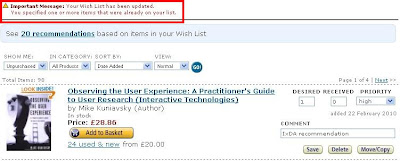Wednesday, 19 January 2011
Sunday, 26 September 2010
UserActionTracer: a tool for improving the quality of online surveys?
There are many pros and cons to collecting user data online, one of the greater cons from the researchers' point of view is the uncertaintly as to whether participants are paying attention and are answering as best they can.
According to the British Psychology Society blog, one new tool may help remove some of those niggling doubts.
The UserActionTracer collects data such as mouse movements, all inserted text, response times, unnaturally fast click-through rates and the selections made to try and identify suspicious changes or unnatural behaviour.
The idea is that this data could be compared to the participant's results and a second source of info, and that this might help to eliminate survey results that are not of the standard desired.
It could also be used prior to the study's launch to see which questions cause users to go back and correct entries, or to click-through without giving the question the thought they require.
Well they do say preparation is everything. Let's hope this tool manages to improve the quality of online research so researchers can more confidently harness the benefits of the internet.
Tuesday, 25 May 2010
Focus groups: taking care of the details and the participants
- Participant profiles
However, language skills must be considered when drawing up the groups so that people understand each other ok and do not feel like they're in an English class!
Slightly smaller group sizes can be a good idea if the users are not super confident or fluent speakers, (I reckon 4 is a good number).
Let's face it, you've got to look after your users, and if they are uncomfortable, then something has gone horribly wrong.
- Set up
- Technique
Monday, 12 April 2010
Wednesday, 7 April 2010
Shock! Horror! Dubious conclusion to Jakob Nielsen's post "Horizontal Attention Leans Left"
"Web users spend 69% of their time viewing the left half of the page and 30% viewing the right half.
[ok so far]
A conventional layout is thus more likely to make sites profitable."
[hmmmmm, profitable?!]
Jakob's conclusion could be right, but not based on this argument alone. It's a bit of a wild leap for someone who is usually so black and white about things.
If he had said:
"Web users spend 69% of their time viewing the left half of the page and 30% viewing the right half. A conventional layout is thus more likely to be more efficient/save users time and energy/make life easier/improve user perception and therefore, possibly as a result make the owners a ton...." well maybe.And there was me relying on Jakob to keep a bit of discipline and order among a world full of snake oil sellers!!! Hey ho.
What do you think?
Monday, 22 February 2010
The long way round is the wrong way round

Saturday, 23 January 2010
We are creatures of habit; why it's worth sticking to some design conventions
Having scrolled up and down, and having tried different pages, I eventually found it.
However, later that day, yet another site, and this time the RSS icon is square, though small and GREY, almost transparent. And yet I had no problem "seeing" it.

